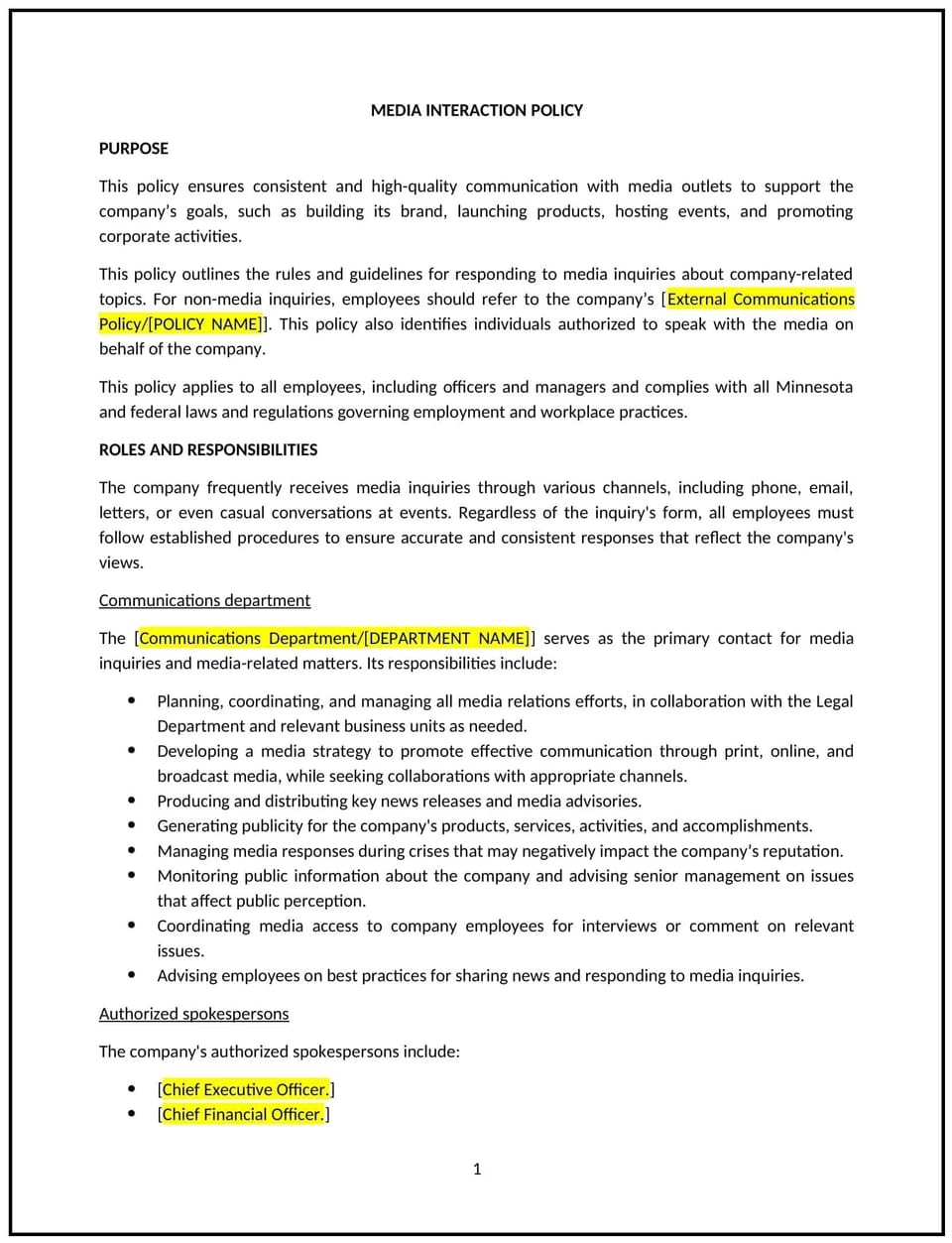Media relations policy (Minnesota): Free template

Media relations policy (Minnesota)
This media relations policy is designed to help Minnesota businesses effectively manage interactions with the media and public relations efforts. It outlines the procedures for dealing with media inquiries, crafting company statements, and ensuring consistent and accurate communication on behalf of the organization. The policy also clarifies the roles and responsibilities of employees when engaging with media outlets.
By implementing this policy, businesses can maintain a professional relationship with the media, protect their reputation, and ensure that all communications align with company values and objectives.
How to use this media relations policy (Minnesota)
- Define authorized spokespersons: Identify key individuals within the company who are authorized to speak with the media, such as senior executives, PR representatives, or legal counsel, and outline the process for coordinating responses.
- Set guidelines for media inquiries: Establish clear procedures for handling media inquiries, including how to direct questions to the appropriate spokesperson, how to respond to urgent media requests, and how to keep employees informed.
- Develop key messaging: Provide a framework for creating consistent and clear messaging that reflects the company’s values, vision, and objectives. Ensure that all public statements align with these core messages.
- Address social media and online presence: Include guidelines for managing media relations on social media platforms, including how employees should respond to media mentions or inquiries on company pages.
- Manage crisis communication: Outline the steps for managing media relations during a crisis, such as a product recall, data breach, or public controversy. Provide guidance on delivering timely, transparent, and accurate information to the media.
- Promote media training: Offer media training for key employees to ensure they are prepared to engage with journalists, respond to questions, and represent the company effectively in interviews and press releases.
Benefits of using a media relations policy (Minnesota)
Implementing this policy provides several advantages for Minnesota businesses:
- Protects company reputation: By controlling media interactions and ensuring consistent messaging, businesses can protect their reputation and reduce the risk of misinformation or negative publicity.
- Strengthens brand identity: A well-executed media relations strategy can help businesses establish a strong public presence and reinforce their brand message in the marketplace.
- Improves crisis management: Having clear media protocols in place enables businesses to respond quickly and professionally to any potential crises, minimizing the impact on the company’s reputation.
- Builds media relationships: A structured approach to media relations can help businesses develop strong, positive relationships with journalists and media outlets, leading to more favorable coverage.
- Reflects Minnesota-specific considerations: Tailors the policy to Minnesota’s local media landscape, addressing state-specific regulatory requirements and cultural sensitivities that may impact media interactions.
Tips for using this media relations policy (Minnesota)
- Communicate clearly: Ensure all employees, especially those in customer-facing or leadership roles, are aware of the media relations policy and know when and how to direct inquiries to authorized spokespersons.
- Be proactive: Stay ahead of potential media stories by providing regular updates, press releases, or public statements about key company events, new products, or corporate milestones.
- Monitor media coverage: Regularly track media coverage and social media mentions to stay informed about how the company is being represented and to address any issues promptly.
- Train employees: Offer media training sessions for key employees, helping them develop the skills necessary to effectively engage with the media and represent the company in interviews.
- Review regularly: Review the policy periodically to ensure it aligns with current media trends, company changes, and any shifts in Minnesota’s media regulations or public relations best practices.
Q: Who is allowed to speak to the media on behalf of the company?
A: Businesses should designate specific individuals, such as the CEO, PR team members, or a spokesperson, to handle media inquiries. Employees should be instructed to direct any media requests to these authorized individuals.
Q: How should employees respond if they are contacted by the media?
A: Employees should not speak to the media unless they are an authorized spokesperson. Instead, they should refer the media inquiry to the company’s designated PR or communication team.
Q: What should businesses do if the media requests information during a crisis?
A: During a crisis, businesses should follow a pre-established crisis communication plan. The company should respond quickly with accurate, transparent information to prevent misinformation or negative publicity.
Q: Can employees engage with the media on social media?
A: Employees should refrain from engaging with the media on social media unless they are specifically authorized to do so. The policy should provide guidelines on how employees should handle media mentions or requests on platforms like Twitter or LinkedIn.
Q: How does the company ensure consistent messaging in media communications?
A: Businesses should create key messaging documents that outline the company’s core messages, values, and responses to common inquiries. All media communications should align with these messages to ensure consistency.
Q: What should businesses do if they receive negative media coverage?
A: If negative coverage arises, businesses should quickly assess the situation, issue a public response or correction if necessary, and follow their crisis communication protocols to mitigate any damage.
Q: How can businesses maintain good relationships with journalists?
A: Businesses should build positive relationships with journalists by being responsive, transparent, and respectful. Regularly providing updates, responding to inquiries promptly, and offering accurate information helps to foster goodwill with the media.
Q: How often should this policy be reviewed?
A: The media relations policy should be reviewed at least annually or whenever there are significant changes in the company’s media strategy, industry trends, or Minnesota’s media landscape.
This article contains general legal information and does not contain legal advice. Cobrief is not a law firm or a substitute for an attorney or law firm. The law is complex and changes often. For legal advice, please ask a lawyer.


